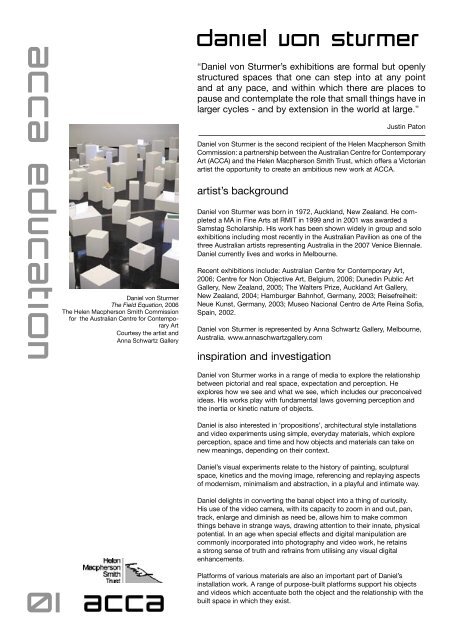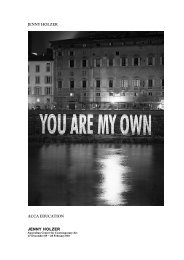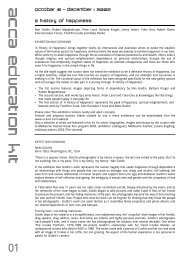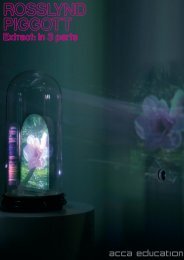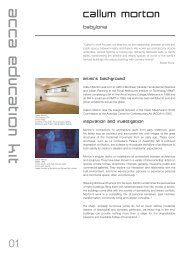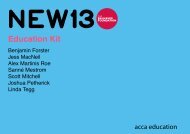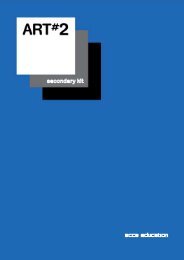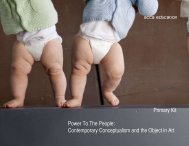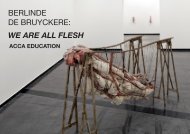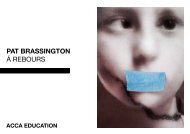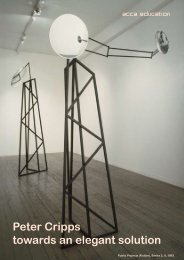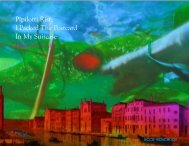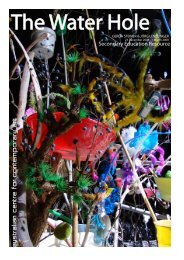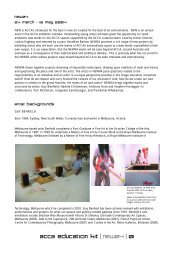DVS ed kit.indd - ACCA
DVS ed kit.indd - ACCA
DVS ed kit.indd - ACCA
You also want an ePaper? Increase the reach of your titles
YUMPU automatically turns print PDFs into web optimized ePapers that Google loves.
acca <strong>ed</strong>ucationDaniel von SturmerThe Field Equation, 2006The Helen Macpherson Smith Commissionfor the Australian Centre for ContemporaryArtCourtesy the artist andAnna Schwartz Gallerydaniel von sturmer“Daniel von Sturmer’s exhibitions are formal but openlystructur<strong>ed</strong> spaces that one can step into at any pointand at any pace, and within which there are places topause and contemplate the role that small things have inlarger cycles - and by extension in the world at large.”Justin PatonDaniel von Sturmer is the second recipient of the Helen Macpherson SmithCommission: a partnership between the Australian Centre for ContemporaryArt (<strong>ACCA</strong>) and the Helen Macpherson Smith Trust, which offers a Victorianartist the opportunity to create an ambitious new work at <strong>ACCA</strong>.artist’s backgroundDaniel von Sturmer was born in 1972, Auckland, New Zealand. He complet<strong>ed</strong>a MA in Fine Arts at RMIT in 1999 and in 2001 was award<strong>ed</strong> aSamstag Scholarship. His work has been shown widely in group and soloexhibitions including most recently in the Australian Pavilion as one of thethree Australian artists representing Australia in the 2007 Venice Biennale.Daniel currently lives and works in Melbourne.Recent exhibitions include: Australian Centre for Contemporary Art,2006; Centre for Non Objective Art, Belgium, 2006; Dun<strong>ed</strong>in Public ArtGallery, New Zealand, 2005; The Walters Prize, Auckland Art Gallery,New Zealand, 2004; Hamburger Bahnhof, Germany, 2003; Reisefreiheit:Neue Kunst, Germany, 2003; Museo Nacional Centro de Arte Reina Sofia,Spain, 2002.Daniel von Sturmer is represent<strong>ed</strong> by Anna Schwartz Gallery, Melbourne,Australia. www.annaschwartzgallery.cominspiration and investigationDaniel von Sturmer works in a range of m<strong>ed</strong>ia to explore the relationshipbetween pictorial and real space, expectation and perception. Heexplores how we see and what we see, which includes our preconceiv<strong>ed</strong>ideas. His works play with fundamental laws governing perception andthe inertia or kinetic nature of objects.Daniel is also interest<strong>ed</strong> in ‘propositions’, architectural style installationsand video experiments using simple, everyday materials, which exploreperception, space and time and how objects and materials can take onnew meanings, depending on their context.Daniel’s visual experiments relate to the history of painting, sculpturalspace, kinetics and the moving image, referencing and replaying aspectsof modernism, minimalism and abstraction, in a playful and intimate way.Daniel delights in converting the banal object into a thing of curiosity.His use of the video camera, with its capacity to zoom in and out, pan,track, enlarge and diminish as ne<strong>ed</strong> be, allows him to make commonthings behave in strange ways, drawing attention to their innate, physicalpotential. In an age when special effects and digital manipulation arecommonly incorporat<strong>ed</strong> into photography and video work, he retainsa strong sense of truth and refrains from utilising any visual digitalenhancements.01Platforms of various materials are also an important part of Daniel’sinstallation work. A range of purpose-built platforms support his objectsand videos which accentuate both the object and the relationship with thebuilt space in which they exist.
acca <strong>ed</strong>ucationDaniel von SturmerMaterial From Another M<strong>ed</strong>ium, 2001Centre for Contemporary PhotographyCourtesy the artist andAnna Schwartz GalleryDaniel von SturmerCube, 1998Collaboration with Andy Thomsonand Leslie Eastman<strong>ACCA</strong>, MelbourneCourtesy the artist andAnna Schwartz Gallery“In recent projects, von Sturmer has focus<strong>ed</strong> more closely on transforming theviewing conditions in the gallery space, reintroducing a sense of time, as wellas shifting the viewer’s orientation away from conventional and anticipat<strong>ed</strong>views to ones that are unexpect<strong>ed</strong>.” (1)materials and techniquesSome of Daniel’s favourite materials have been scrunch<strong>ed</strong> up paper, Blu-Tack,colour<strong>ed</strong> paper squares, water, polystyrene balls, planks of wood, disposablecups, sticky tape, paper clips, and plasticine etc. “Through his use of the videocamera, Daniel assists these common things to behave in odd and eccentricways, drawing attention to their innate physical potential, activating an inquisitiveengagement with the viewer. The challenge for Daniel is to free his materials fromsymbolic associations, so that it is the viewer who projects their own meaningonto the objects. His interest is with the interplay between what the viewer seesand grapples with and in creating a greater degree of engagement and intrigue.”(2)Daniel explores the inherent quality of a range of materials - string assomething both floppy and rigid, balls that cluster, roll and disperse. Thesematerials, subject<strong>ed</strong> to the effects of various external forces, especially gravity,encourage the viewer to think about space, scale, orientation, weight andgravity.When Daniel is creating a work, he starts with the exhibition space andexamines the entire environment. This includes the dimensions and materialqualities of the floor, the walls, the ceiling and ways in which that space can benegotiat<strong>ed</strong>.In earlier projects, Daniel made use of ‘camera obscura’* and architecturaladjustments to the built spaces, literally bringing the outside world into thegallery, focusing the viewing experience on the simplest of things: an angle oflight or a single landmark.Daniel transform<strong>ed</strong> the gallery space and the ‘white cube’ from a place wherevalu<strong>ed</strong> objects and images would normally fit, to a place where the spaceand the built structure were essential to the work. Daniel makes us considerthe privileges of the exhibition space, where temporarily, these theories donot apply. His interest in the white space of the gallery, and the activity within,confirms his interest in continuing aspects of Brian O’Doherty’s enquiry into thegallery space as a ‘white cube’.O’Doherty states; “A gallery is construct<strong>ed</strong> along laws as rigorous as those forbuilding a m<strong>ed</strong>ieval church. The outside world must not come in, so windowsare usually seal<strong>ed</strong> off. Walls are paint<strong>ed</strong> white. The ceiling becomes the sourceof light. The wooden floor is polish<strong>ed</strong> so that you click along clinically orcarpet<strong>ed</strong> so that you pad soundlessly, resting the feet while the eyes look atthe wall. The art is free, as the saying us<strong>ed</strong> to go, to take on its own life. Th<strong>ed</strong>iscreet desk may be the only piece of furniture.” (3)In an earlier work, Gain and Loss, 1997, Daniel’s collaborative exhibitionwith Leslie Eastman and Andy Thomson, transform<strong>ed</strong> West Space galleryinto a labyrinth of corridors, using screens and windows, camera obscuraand video projections to turn the space outside-in, dismantling the variousframing devices which separate a picture from its context, a gallery from itssurroundings, art from ‘everyday life’.Cube,1998, at <strong>ACCA</strong>, another collaboration with Andy Thomson and LeslieEastman, present<strong>ed</strong> the viewer with a white cube, plac<strong>ed</strong> within the galleryspace. In this work, views of the landscape outside the gallery, were project<strong>ed</strong>onto the outside of the cube. Here Daniel explor<strong>ed</strong> ideas surrounding thegallery space as a ‘white cube’, which is a term often us<strong>ed</strong> by art theorists. (seeBrian OʼDoherty, Inside the white cube: notes on the gallery space. www.societyofcontrol.com/whitecube/insidewc.htm)02*The ‘camera obscura’ (Latin for ‘dark room’) was the ancestor of the modern camera. The camera wasactually a large room that would be enter<strong>ed</strong> by the user. Light entering a small hole in a darken<strong>ed</strong> roomproduces an invert<strong>ed</strong> image on the opposite wall. Us<strong>ed</strong> initially to view solar eclipses, in the seventeenthcentury, the process was made portable by fitting a lens to one end of a box and using a sheet of glassat the opposite end to view the image. www.acmi.net.au/aic/camera_obscura.html.
acca <strong>ed</strong>ucationDaniel von SturmerThe Truth Effect, 2003Commission<strong>ed</strong> as part of NEW03at the Australian Centre forContemporary ArtCourtesy the artist andAnna Schwartz GalleryDaniel von SturmerHorizontal Hold, 2004Museum of SydneyPart of On Reason and EmotionCourtesy the artist andAnna Schwartz GalleryFor the work Plane, 2000, Daniel completely remov<strong>ed</strong> a section of the 1st FloorArtists & Writers Space gallery wall and replac<strong>ed</strong> it with plate glass, whichcontinu<strong>ed</strong> his style of intervention. This open<strong>ed</strong> up the gallery spaces to oneanother; the solid plane of glass barr<strong>ed</strong> access, evoking the ‘look but don’ttouch’ conditioning of the well-behav<strong>ed</strong> gallery visitor.Science Fiction, 2001 featur<strong>ed</strong> a loop of five ‘tricks’, mostly done by running thevideo backwards - a blob of plasticine ‘miraculously’ regain<strong>ed</strong> its cuboid shape;a blob of Blu-Tack leapt up to attach itself to a fingertip; the surface of the waterin a glass tilt<strong>ed</strong> weirdly sideways as in a force field.For the exhibition NEW03 at <strong>ACCA</strong>, for the work entitl<strong>ed</strong> The Truth Effect, 2003,Daniel erect<strong>ed</strong> a tilt<strong>ed</strong> platform which relat<strong>ed</strong> to the floating ceiling of the Gallery,and which chang<strong>ed</strong> the dynamic sense of the rear of the gallery space. Theplatform support<strong>ed</strong> projectors and luminous screens, which present<strong>ed</strong> imagesof colour, shape and material experiments. The angl<strong>ed</strong> platform function<strong>ed</strong> as apicture plane, orientating the viewer’s engagement with the work and the spaceof the gallery. Within this defin<strong>ed</strong> space, Daniel orientat<strong>ed</strong> the viewer as subjectby staging an experiment; a play of visual and material action.For the work Horizontal Hold, 2004, Museum of Sydney, part of On Reason andEmotion, for the 14th Biennale of Sydney, Daniel present<strong>ed</strong> a room lit brightlywithin the Museum, which was clearly visible from the street outside. Inside, aprojection of tendrills of shr<strong>ed</strong>d<strong>ed</strong> paper, continuously crawl<strong>ed</strong> from right to leftinside the space, taking on a strange alien-like form. This continual shr<strong>ed</strong>dingof paper, pertinent to the site, in Sydney’s main business district, comment<strong>ed</strong> inpart on the gre<strong>ed</strong> and excesses of the business community and the shr<strong>ed</strong>ding ofimportant documents.In the work Screen Test, 2004, ordinary objects slid, bounc<strong>ed</strong>, and knock<strong>ed</strong> intowalls according to an alternative gravity. Project<strong>ed</strong> onto a corner-shap<strong>ed</strong> screen,the pictorial space of this synchronis<strong>ed</strong> video, extend<strong>ed</strong> the two-dimensionalplane of the video image into the space of the gallery, disorientating the visitor.In The Field Equation, 2006, Daniel respond<strong>ed</strong> to the voluminous gallery at<strong>ACCA</strong>, by fragmenting the space, creating a field of plinths at varying heightswhich support<strong>ed</strong> a range of objects, videos and projection screens. The workencourag<strong>ed</strong> the viewer to enter the gallery space and move around it, to f<strong>indd</strong>ifferent viewpoints. Connections between objects and videos chang<strong>ed</strong> atdifferent vantage points. Some elements such as balls, reappear<strong>ed</strong> in differentworks and in different states of being i.e. individual polystyrene balls, film<strong>ed</strong> andproject<strong>ed</strong> onto one of the small screens, which rac<strong>ed</strong> at high spe<strong>ed</strong> toward theviewer, also appear<strong>ed</strong> in real space in a cluster<strong>ed</strong> form, looking like part of ascience experiment.Like the work of the Renaissance artists, Alberti and Brunelleschi, if you plac<strong>ed</strong>a screen across the opening in front of The Field Equation, and view<strong>ed</strong> Daniel’swork as a foreshorten<strong>ed</strong> picture, you could see abstract principles of geometrywith grids and viewing points. Unlike painting, however, the animat<strong>ed</strong> screensand objects could be view<strong>ed</strong> from a number of angles, not necessarily from onefrontal position. For The Field Equation, the exhibition space became a field ofexperience; both abstract and real and a kind of landscape which you couldwander through and experience moments of both mobility and stasis, thoughtand contemplation. (4)Daniel von SturmerThe Field Equation, 2006The Helen Macpherson Smith Commissionfor the Australian Centre for Contemporary ArtCourtesy the artist andAnna Schwartz GalleryPhoto: Andrew Curtis03Daniel describes The Field Equation by saying, “I like to think about the objectsas propositions, about the way we experience things. We have knowl<strong>ed</strong>ge ofthem by their uses and functions - we know what to do with string or if we caninvent something else to do with it, and it’s that inventive moment which I think isinteresting.”(5)In 2007, Daniel von Sturmer was select<strong>ed</strong> to represent Australia at the 52ndInternational Art Exhibition, Biennale di Venezia, 2007. His work The Objectof Things, 2007, includ<strong>ed</strong> a wooden platform which flow<strong>ed</strong> across the interiorspace of the Australian Pavilion, supporting a range of video screens, creatinga sense of space, scale and orientation through experiments with gravity andweightlessness, movement and stillness.Professor Richard de Marco, Demarco European Art Foundation, said: ‘In all myyears of visiting the Australian Pavilion, since the day it open<strong>ed</strong>, I believe thatDaniel’s exhibition reveals its true beauty and elegance as a space. It is inde<strong>ed</strong> a


